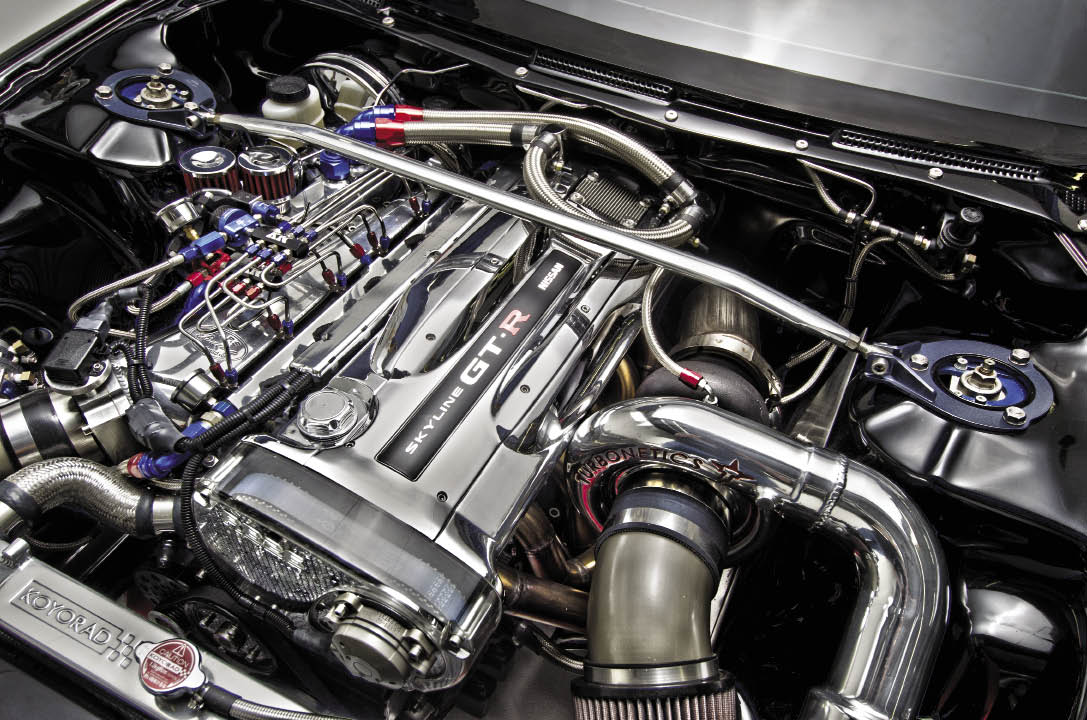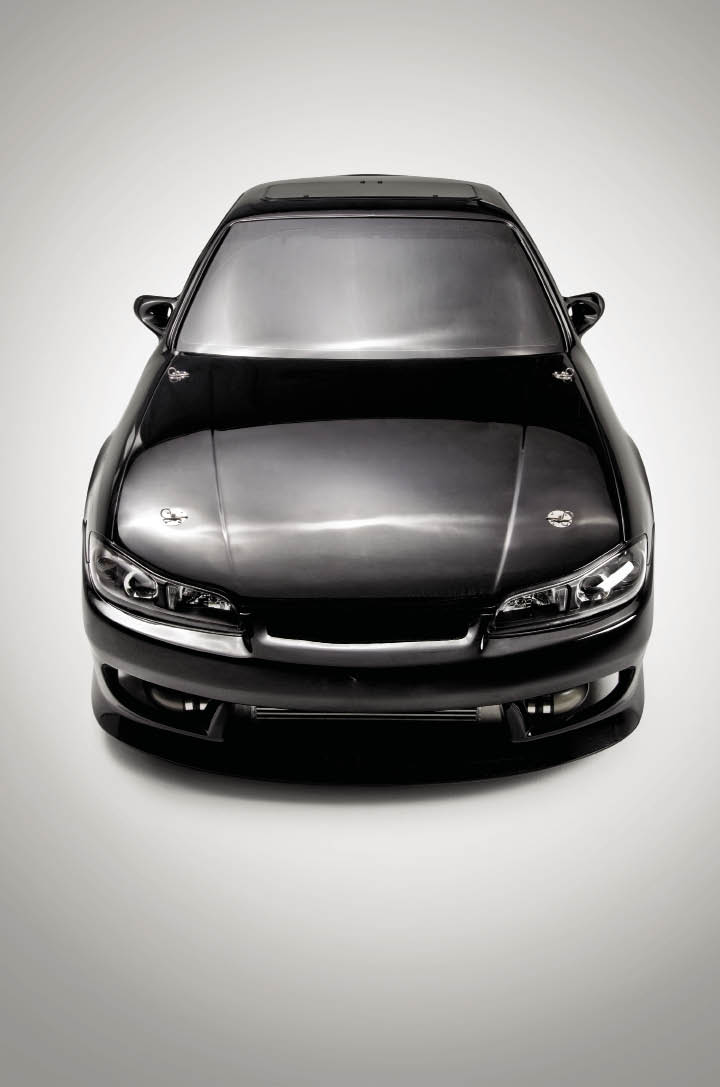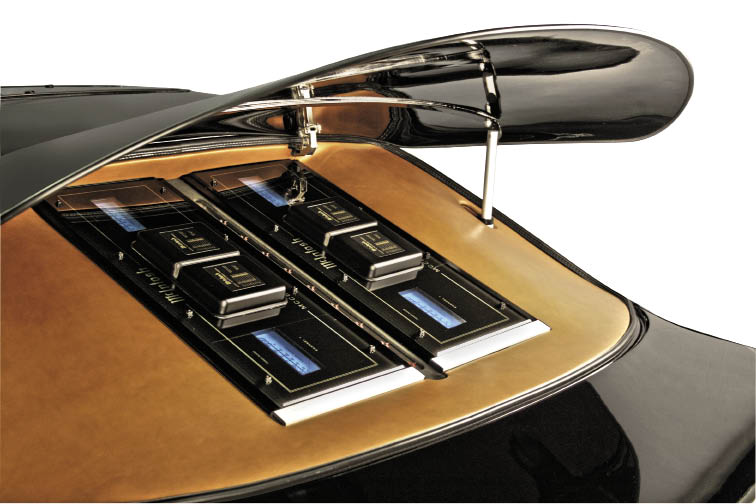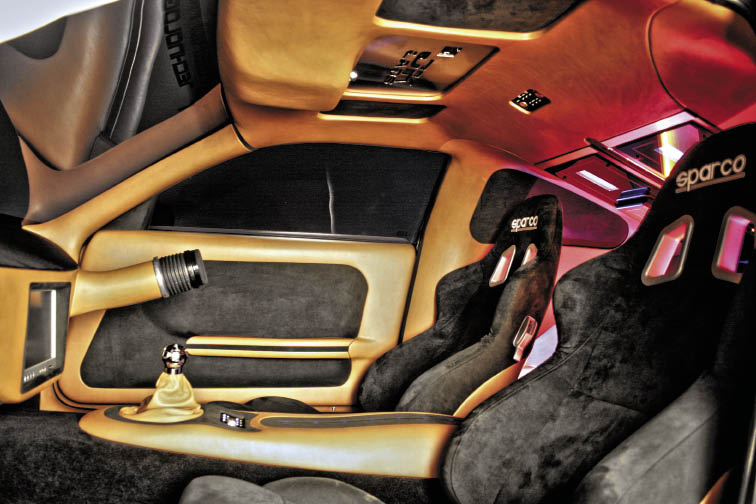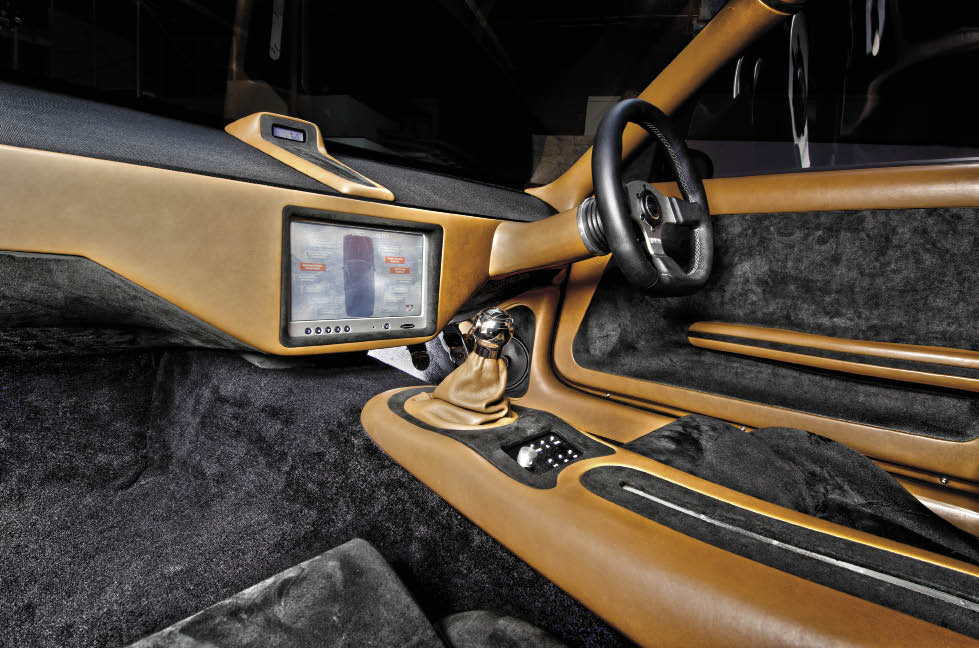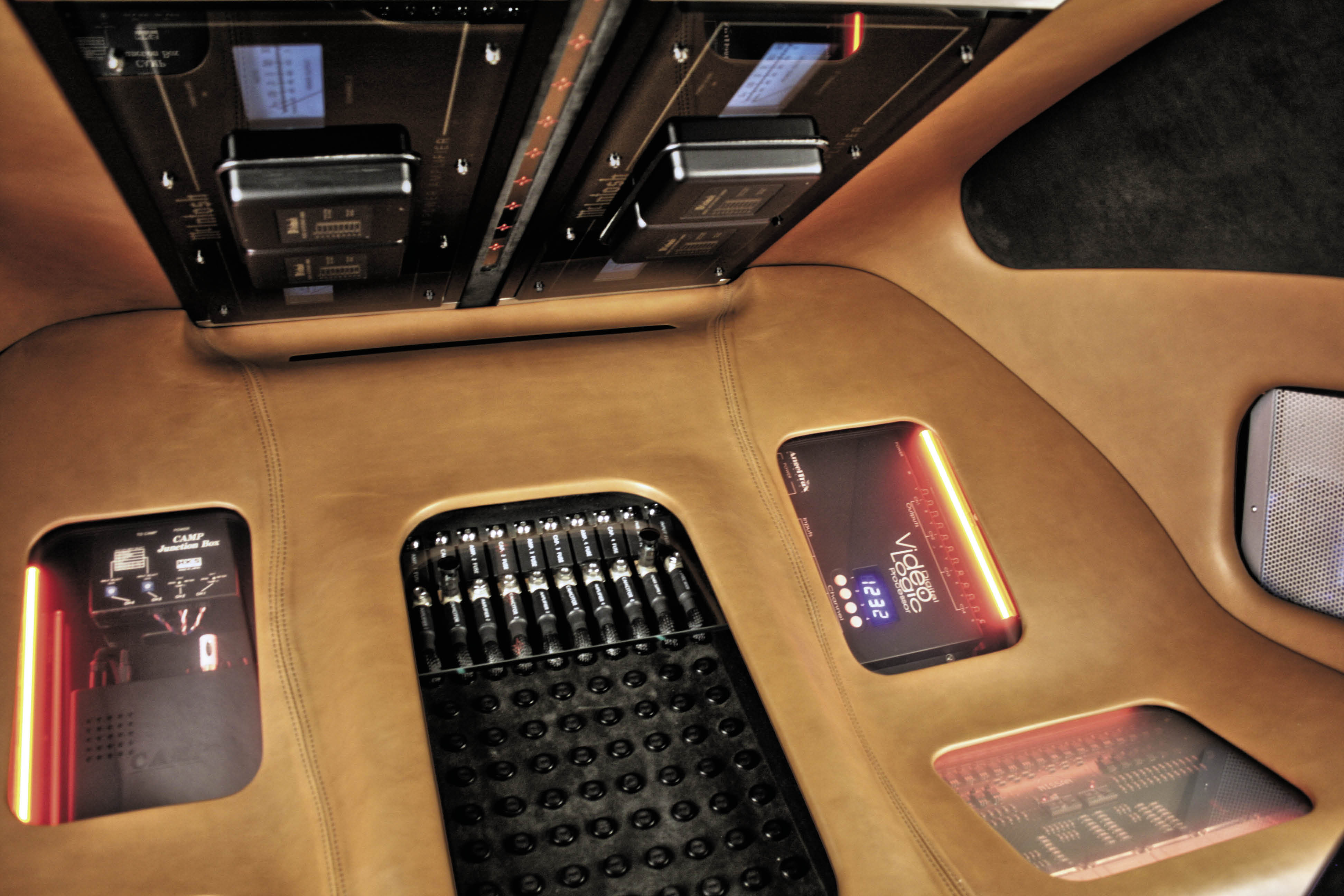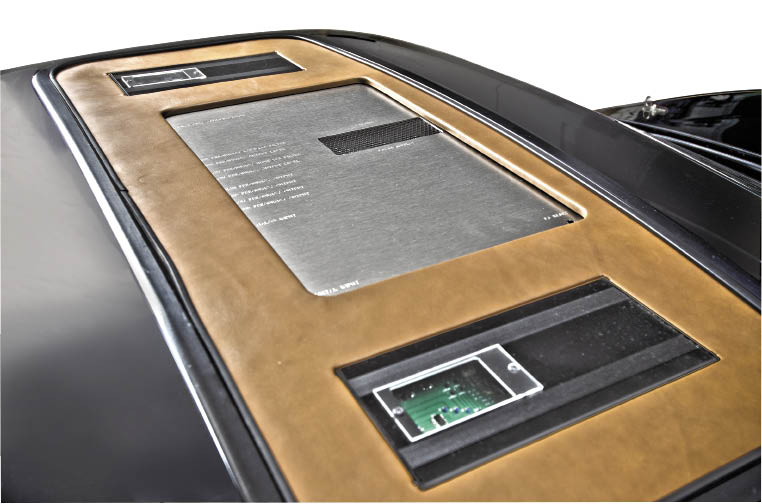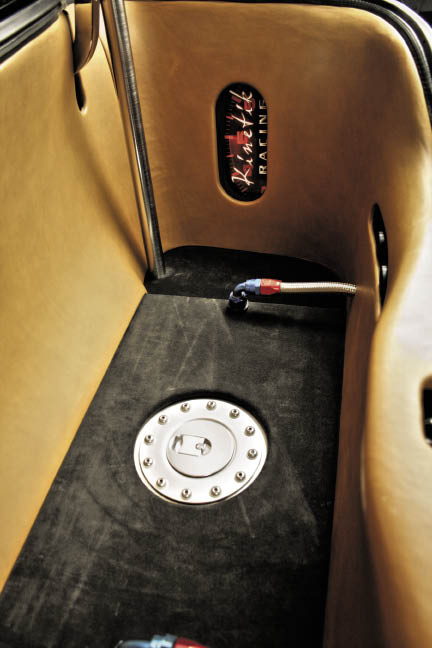Photos by Joshua Buwalda & Klifton Keplinger
Scott Buwalda of Cumming, GA owns the 1995 Nissan, um, car, shown here. Because he has done such a great job on the car, you may not recognize it at all. It’s a 260SX...sorta. You see, with nearly 12,000 hours spread over seven years and enough money to buy a nice little house, the car no longer looks like a run-of-the-mill sports coupe. No, it’s much more, and I’m going to try to explain the project.
Let’s start under the hood. The power plant is an N1 block crate-motor RB26DETT, normally found in the Nissan Skyline. The crate motor was enhanced using Tomei, Ross, Nismo, GReddy and HKS components. The head was ported and polished by Simon Drummond in New Zealand. The crank was strengthened and balanced, then mated to the flywheel, clutch and pressure plate which was balanced to within 0.001 grams. All the plumbing was done with Spectre, Magnabraid and Jegs expandable stainless braided shield, and a Rotora Import Pro Shop (RIPS) catch can captures any oil vapours. The engine was then run for 4,000km to ensure flawless performance. In case you’re curious, yes, the run-in was done in New Zealand, on the road, in a donor R33 chassis.
Strapped to the side of the head is a Turbonetics Super T-Series T04 Turbo complete with a 50 psi mechanical boost control. The exhaust manifold was fabricated from 316 stainless and includes a 4-inch down-pipe that feeds into a Magnaflow muffler and out to a 5-inch outlet. A Turbonetics NewGen wastegate fitted with a 15lb spring ensures accurate boost control. Up front, a 20 x 12 x 4.5-inch cored Spearco custom intercooler helps extract heat from the compressed air that flows through custom-bent 4.5-inch stainless piping that was ceramic coated.
Rounding out the power production is a Nitrous Express EFI Direct Port kit that was configured with 250-shot nozzles. A 5-pound bottle with a remote bottle opener feeds 4-AN tubing from the trunk to the solenoids that were mounted with Irvan Smith brackets. 4-AN lines also feed the fuel side and the whole thing is controlled by a Nitrous Express Maximizer II power Controller. An Aeromotive fuel pump, regulator and dual filters ensure the 50/50 blend of C-16 and Q-16 race fuel from the Race Safe 7-gallon cell flows consistently through Russell braided 10-AN lines. Six SARD 1,200cc injectors dump atomized fuel into a RIPS single 90mm throttle body intake plenum. Splitfire coils ignite Blitz 6105-8 spark plugs. Controlling the engine is a full AEM EMS computer system complete with a 5-bar map sensor and wideband O2 sensor. An HKS CAMP system lets Buwalda keep tabs on EGT, Boost, Oil pressure and voltage. Power from the ultra-smooth running engine passes through a twin-plate Ogura racing clutch into a Skyline GT-R32 5-speed transmission that was converted to rear wheel drive only operation.
All engine components have been polished, chromed, ceramic coated or powder coated, while the block itself was jet coated. All bolts were converted to stainless steel socket head cap screws and nuts are grade 8 stainless.
Buwalda strapped the beast to the dyno at Top Speed Motorsports in Alpharetta, GA and laid down 879 horses at the rear wheels without spray while running Q16 fuel. He figures hitting the bottle would bring the output very close to 1,000hp.
An engine like this needs a classy home. Buwalda invested a significant amount of time in body and chassis work on the car. More than 370 holes were filled in the engine compartment. Everything that wasn’t being used was filled with 22-gauge steel or simply weld-filled. Closer inspection of the engine compartment reveals that there are no right angles between any panels. Buwalda sighs and explains that it took the better part of a summer to radius each and every joint by hand using high quality body filler and lots of meticulous sanding. The result is a perfectly smooth engine bay.
Work continued with the removal of all the OEM seam sealant in the car for preparation for solid wire-fed seam welding. This was followed with grinding to ensure a perfectly smooth finish that matched the engine compartment. Around this time Buwalda realized that there were going to be steering rack clearance problems. Not wanting to simply hammer out the firewall, he chose to graft a large section of firewall from a JDM Silvia chassis in place. The graft extended from the transmission tunnel up to and along the cowl line. The panel was welded from both sides to ensure its rigidity. Buwalda reports that even S14 experts have a hard time determining if this is a converted USDM car or a JDM one.
Work continued with an S15 front end conversion, starting with modification of the core support to ensure the deep S15 projector light assemblies fit. The next step and one that Buwalda credits as being one of the more complex bodywork tasks was the fabrication of hybrid S14/S15 fenders. OEM S14 fenders were cut so that only the mounting surface at the base of the fender and two thirds of the body line remained. Similarly, S15 fenders were mounted to the fenders and the opposite material removed. Mounted to the car, an irregular S pattern was cut out of both. The two pieces were then stitched together methodically. With some patience, the fenders mated together and simultaneously blend into a Vertex front bumper. The new fenders were welded to the A-pillar so that no seam exists, and they mold into the side skirts and door sills as well. The same treatment was given to the side skirts and rear bumper to ensure a flush fit.
Buwalda created a new rear window out of fibreglass. This panel opens to reveal audio equipment underneath. However, it required the creation of a water channel and seal just as would be found on a hatchback. Buwalda included fake defroster lines in the rear window paint, and having seen it in person, I can attest to it looking like heavily tinted rear glass. The motorization of the window was planned and detailed extensively before being executed, including days of searching for the perfect hinges and actuators to ensure the final result would operate flawlessly.
The car was prepped with a typical primer then sealer technique, and then treated to two base coats and four coats of clear. The choice of color was Sikkens Jet Black. This paint has the reputation of being the blackest on the market today, and Buwalda points out that it makes most OEM black paints look grey by comparison. The only graphic on the car is a Hybrid Audio Technologies logo across the windshield – Buwalda likes things clean. If you think the paint looks good, you’re right, but it took three attempts before he gave it his seal of approval.
For the wheels, Buwalda chose Volk Racing GT-U 18x9 and 18x10-inch wheels, and wrapped them in Falken RT-615 rubber sized at 235/40 in the front and huge 275/35 out back. The brakes are from a Nissan 300ZX Turbo and were powder-coated red to flow with the accent color scheme of the car. Goodridge braided lines, SSBC slotted and drilled rotors and Hawk pads round out the stopping hardware.
Work on the interior of the Nissan started with the filling of more than 800 holes in the chassis to ensure a perfectly flat and seamless foundation. Portions of the floor and firewall were removed or modified to allow for the eventual installation of the mid-bass speakers in the kick panel area. These areas were reinforced with enclosures welded together from 10mm thick hot rolled steel. Likewise, the area under the seats was removed and replaced with 6mm thick stainless steel to provide a solid a foundation for the seats. Once all the body work was done, the entire interior was treated to a chemically catalyzed truck bed coating that provides a hard rubber surface. On top of that, Buwalda applied one layer of B-Quiet sound deadening to the entire interior. The floor also received a layer of lead septum core shielding to further reduce vibration that could potentially alter how the listener would perceive the speaker locations.
The aforementioned kick-panel speaker locations are now home to a set of 8.85-inch Hybrid Audio Technologies Legatia L8SE drivers. The drivers are mounted to birch baffles that were positioned using lasers. The enclosure behind the drivers can breathe through a grill into the fender area, presenting an infinite baffle installation. The mounting baffle is almost two inches thick and non-hardening clay was used extensively to further reduce panel vibration in the enclosures and the surrounding area, including in the doors. Buwalda is the President and founder of Hybrid Audio Technologies, and with his own company at his disposal, he hand-matched the drivers after burning them in to ensure both sides of the vehicle would sound identical. IXOS 11-gauge Gamma Geometry speaker wire, protected in color-coded expandable tubing was attached to each speaker with 4% silver-content solder. Surprisingly, the installation of the mid-bass drivers was not complete. Waveguides were constructed to direct the output of the speakers toward the listeners and to provide a way to highlight the speakers cosmetically. The kick panel trim in which the guides reside runs the entire length of the door and were wrapped in unprocessed horse leather. Grills were fabricated from expandable mesh sandwiched between MDF panels.
Next in the audio system installation, were the mid-range and tweeters in the front stage. At the extreme outside corners of the interior, where the windshield wiper cowl and the uni-body chassis meet is where an additional set of Baltic Birch mounting panels was created. The panels were placed and aimed through an extensive trial and error process that was complimented with in-car acoustics modelling. Behind the baffles, cabinets were roughed in using a mixture of fiberglass resin and body filler. The mixture was poured liberally into the cavity to seal it off from the mid-bass enclosures. Like the mid-bass installation, infinite baffle vents with extruded metal grills were installed on top of the cowl and remain visible from the engine compartment. Stainless steel teardrop shaped panels were fabricated in order to align the output of the midrange and the tweeter in what is called a “zero delay plane.” This means that the sound from both arrives at your ear at exactly the same time. Again, hand-matched post burn-in Legatia L4SE midrange drivers and Legatia L1 Pro R2 tweeters were selected. Both are wired with equal lengths of 11-gauge IXOS speaker cable.
The midrange and tweeters are hidden under an acoustically transparent grill that covers the entire top portion of the dash. The grill was fabricated from 15mm square tube stock. The underside of the dash wears a similar grill, but is covered in acoustically absorptive material to separate the output of the mid-bass driver from that of the midrange and tweeter. The remainder of the dash, firewall and mounting surfaces were treated with foam acoustical treatment to limit sound reflection.
Under the upper dash grill is also where the systems sole subwoofer resides. Before the subwoofer could be mounted, extensive work was done to the firewall and a stainless steel welded notch was created. With the prep work done, a custom-assembled 12-inch Fi Car Audio subwoofer was mounted in the very center of the dash. A cylindrical enclosure was fabricated out of Baltic Birch, fiberglass and chop mat. It extends down to the transmission tunnel where it is vented to the exterior via a 5 x 9 inch opening.
The stock crash bar served as the foundation for the custom dashboard. MDF and aluminum flat stock was used to create the new dash, and it was covered in matching unprocessed horse leather. In the front edge of the dash is a 10.1 touch-screen monitor. This monitor displays vital system information and is connected to an on-board computer system..
Moving forward with the construction of the interior, Buwalda ran all of the vehicle’s wiring – both audio and OEM, up through the A-pillars. The pillar covers are made entirely of fibreglass and pressure fit in place. The OEM wiring runs inside the pillars while the audio system wiring is on the outside. This ensures nothing is on the floor of the vehicle which could possibly vibrate, rattle, buzz, hum or otherwise detract from the acoustic experience.
Continuing on the effort to provide a silent listening environment, Buwalda fabricated custom door panels from MDF and fibreglass. There are no switches or controls in the doors, as the on-board computer takes care of everything. Even the process of opening the door is done via the computer. The new door panels, finished in leather and Alcantara are not only extremely rigid, but add an impressive three inches of width as compared to the stock panels. This helps reduce sound reflections close to the driver and further focuses the soundstage.
The only visible off-the-shelf components in the interior are a set of Sparco Milano 2 seats (which, incidentally, were modified with matching leather inserts), a Globe R shift knob, a Faster steering wheel, Cromo pedals and racing harnesses. Everything else was upholstered in black Alcantara Suede and saddle leather over custom made panels. The carpet is real English Wilton Wool, not surprisingly, imported from England.
The ceiling of the Nissan is home to a custom panel that houses a heavily modified Denon DCT-Z1 head unit and a DEQX 2.6P from DEQX Australia. Uniquely, the panel is shaped in such a way that it allowed for acoustic absorption panels to be installed directly above the listeners’ heads. The DSP unit is trimmed in stainless steel that was laser cut with the JK Labs logo. Who is JK Labs you ask? They were responsible for more than 1,500 hours worth of modification and upgrades to both the source unit and the processor. They also provided the electronics profile that runs the audio system, as well as links to the button control panels around the car and the source unit remote control. Upgrades to the source unit included upgraded timing circuitry, the installation of a 75 ohm silver coaxial digital output and the removal of unnecessary hardware that would not be part of the final installation. The digital output then feeds through a proprietary interface into the processor. This allows the processor to observe the function of the head unit based on track selection and volume level and apply specific tuning features that further maximizes the system’s performance.
I mentioned that the car was completely controlled by a dedicated computer system. Some of the highlights of the computer include Voltage monitoring at 24 different points in the vehicle, Fuse status monitoring at 24 points, temperature indication at 8 locations with integrated warning levels, Security system control and vehicle control for windows, locks, lights, etc. A panel was created that extends from the floor behinds the seats and slopes gradually upwards to roughly where the car’s parcel shelf would have been. In this panel is a 84-location fuse array, the HKS CAMP system, an Angel Trax AV44 matrix switcher and the vehicle’s external air conditioning system. The electronics are mounted in illuminated tubs that are covered with activated plasma glass. These glass panels go from opaque to clear when voltage is applied to them.
Audio signals from the DEQX processor are fed to four massive McIntosh MCC602TM amplifiers that were mounted on a custom tubular steel rack. Because each amplifier weighs about 50 pounds, the amplifier rack features 6 points of contact with the vehicle to ensure it is rock solid and stable. Each amplifier, just as with all the other fasteners in the car, was mounted with hex head stainless hardware.
Power connections for each amp were routed to the power center, located under the panel behind the seats. IXOS Professional GTI 1/0-gauge and 4-gauge cable was used. There are four individually fused 1-Farad stiffening capacitors in the power center that are connected together electrically by custom machined brass buss bars. There are two Kinetik Racing KR5112 Power Cells in the trunk, one on each side. These are recharged by a modified PowerMaxx Ohio Generator alternator with an external voltage regulator.
Each speaker is connected to a single amplifier channel– one pair to the tweeters, one pair to the midrange and one pair to the mid-bass drivers. Both channels of the last amp are connected to the dual voice coil subwoofer, providing it with 600W of effortless power. Signals for the amps are fed using IXOS IX-3 short run interconnects. Two of the amplifiers are mounted above the rear seat panel, and the other two are visible when the motorized ‘rear window’ is open.
Wrapping up the rear of the car is the trunk area. In addition to housing a pair of Kinetic power cells, the trunk is also home to the top of the fuel cell that was mounted to a custom steel platform on the floor. The braided fuel feed and return lines are visible on top, but a false floor also exists to provide an OEM appearance. You can also see the nitrous tank through an opening in the trunk’s front wall.
If you are getting the idea that building this vehicle took an incredible amount of planning and thought, then you are starting to get the idea of the intent of the build. Attention to detail was the mantra, and even if it seemed like a particular step of the project was going to take what seemed like forever, Buwalda didn’t back down from the challenge.
Helping build the car was Dwayne Blackwood who assisted with fabrication, Jeremy Carlson who helped with electrical engineering and Clay Howard who assisted with the computer engineering. The sponsor and supporter list for the project is topped with Buwalda’s company, Hybrid Audio Technologies, who provided not only the speakers, but significant financial support as well.
When Buwalda set off on this project, his intent was to build the world’s most complete vehicle in terms of speed, style and sound. In terms of power, almost 1,000hp and an exotic drivetrain covers all the go-fast requirements. The attention to detail around the meticulous bodywork and the blacker than black paint without any graphics more than takes care of the style factor. The audio system, built from no-holds-barred equipment and techniques has garnered itself the highest score ever in IASCA (or any car audio competition format for that matter) with 996.5 points. That puts a check mark beside the sound column for sure.
ESSENTIALS
Vehicle: 1995 Nissan Silvia Spec GT-R
Owner: Scott Buwalda
Location: Atlanta, GA. USA
Engine Displacement: 2.6 liters
Horsepower: 879
Website: www.buwaldahybrids.com
Club Affiliation: Team Hybrids (the stereo competition group)
ENGINE
- Engine Code: Nissan Skyline GT-R33 RB26DETT N1 specification 2.6-liter inline six cylinder crate motor engine set
- Turbo: Turbonetics Super T-Series T04 turbo (700 – 1,000 HP)
- Nitrous System: Nitrous Express EFI
- Air Intake & Filter: K&N filter
- Manifold: Rotora Import Pro Shop (RIPS)
- Fuel Rail: SARD RB26DETT fuel delivery tube
- Fuel Press Reg: Aeromotive P/N 13110 Pro-Series Fuel Pressure Regulator
- Fuel Pump: Aeromotive P/N 11104 Eliminator 1600 HP
- Cams: Tomei Procam 10.85mm 270IN 260EX
- Cam Gears: GReddy adjustable cam pulleys
- Intercooler: Turbonetics Spearco
- Blow-Off Valve: Turbonetics Godzilla
- Wastegate: Turbonetics NewGen wastegate
- Injectors: SARD 1200cc injectors (X6) low impedance
- Timing Control: AEM EMS full computer unit
- Spark Plugs: Blitz 6105-8 spark plugs (NGK 8 series, 0.8mm gap, platinum, JIS plug)
- Coil: Splitfire coils SF-DIS-001
- Grounding System: Custom 1/0-gauge grounding
- Pistons: Ross Racing pistons
- Head Gasket: Nismo 1.5 mm metal cylinder head gasket
- Other Gaskets: Nissan Skyline RB26DETT complete OEM gasket kit
- Hardware (Bolts): ARP head and rod bolts, Calico-coated racing bearings
- Clutch & Flywheel: Twin-plate Ogura Racing Clutch (ORC)
- Transmission & mods: Nissan A31 Cefiro Crossmember with Syko Performance high-shore isolators and mounts
EXHAUST
- Exhaust: Magnaflow muffler
DRIVETRAIN
- Valvetrain: Tomei valve guides, buckets, retainers, & springs
- Axles: Mazworx
- LSD: Kaaz S14 LSD
ELECTRONICS
- AEM
- HKS
- Kinetik Racing Power Cells (KR5112)
- PowerMaxx
INTERIOR
- Shift Knob: Sparco Globe R
- Steering Wheel: Sparco Faster
- Shift Boot: Custom leather
- Gauges: HKS CAMP Multi-player through dashboard monitor
- Seats: Sparco Milano II
- Harnesses: Sparco
AUDIO / MOBILE ELECTRONICS
- Head Unit: Denon DCT-Z1
- Processors: DEQX
- Sub Amps: McIntosh MCC602TM
- Midbass Amps: McIntosh MCC602TM
- Midrange Amps: McIntosh MCC602TM
- High Freq. Amps: McIntosh MCC602TM
- Front Monitors: Zenarc touch-screen
- Subwoofers: (1) Fi Car Audio 12-inch custom subwoofer
- Subwoofer Enclosure: Infinite baffle
- Mid Bass: Hybrid Audio Technologies
- Legatia L8SE, QTY 2
- Mid Range: Hybrid Audio Technologies
- Legatia L4SE, QTY 2
- Tweeters: Hybrid Audio Technologies
- Legatia L1 Pro R2, QTY 2
- Main power wire: IXOS
- Alternator: PowerMaxx, adapted by Ohio Generator
EXTERIOR
- Body kit / ground effects: Vertex
- Fenders: S15 Front-end conversion
- Headlights: Nissan Silvia S15
- Taillights: JDM taillights
- Graphics / Custom Paint colors: Sikkens Jet Black (blackest black on the market available today)
WHEELS / TIRES / BRAKES
- Wheels: Volk Racing GT-U, 18 X 9 (front), and 18 X 10 (rear)
- Tires: Falken RT-615, 225/40/18 (front), 275/35/18 (rear)
- Front and Rear Rotor Size: SSBC Big Bite Cross Drilled Rotors; Turbo 300ZX OEM diameter (front and rear), one piece rotor, slotted and drilled
- Front and Rear Brake Calipers: Turbo 300ZX OEM aluminum calipers, powder-coated and emblem braised
- Braided Lines: Goodridge stainless steel lines
- Other Parts (fluid, cylinder, pads): Hawk brake pads, 300ZX turbo brake cylinder and brake booster (chrome plated)
SUSPENSION
- Springs/Coilovers: JIC Magic FLT-A2
- Antiroll/Stabilizer Bar: Tanabe Sustec
- Front Strut Brace: Tanabe Sustec
- Bushings: SPL Parts subframe bushings
- Tie Rods: Tein Inner & Outer
- Tanabe Pillow Tension Rods (front)
- Tanabe Camber and Tow Control Arms (front and rear)
- Tanabe Rear Traction Rods (rear)
- Nismo Power Brace
SPONSORS
- Title Sponsor: Hybrid Audio Technologies.
- Platinum-Level Sponsors: B-Quiet, Falken, Fi Car Audio, Mothers Polishes, Waxes, and Cleaners, IXOS, Nitrous Express, Select Products, SPAL, Syko Performance, Turbonetics, Viper Alarms by Directed Electronics.
- Gold-Level Sponsors: DEQX, Design Engineering, International Allstars, Kinetik, Mackin Industries/Volk Racing Wheels, Neukin Turbo Manifolds, Ohio Generator, Raw Brokerage, Sparco, Top Speed Performance
Related Articles
 A Proper Full-Time Daily - Thanongdeth Chanthavong's 1999 Nissan Skyline
A Proper Full-Time Daily - Thanongdeth Chanthavong's 1999 Nissan Skyline
 Kyle Crangle - 1997 Nissan 240sx
Kyle Crangle - 1997 Nissan 240sx
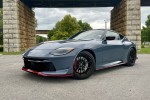 2024 Nissan Z Nismo – Pros and Cons
2024 Nissan Z Nismo – Pros and Cons
 Air Lift Performance... Coilover Kits??!!
Air Lift Performance... Coilover Kits??!!
 Fit Check: Sparco COOL VEST
Fit Check: Sparco COOL VEST
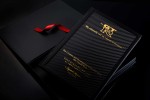 Father of the GT-R, Kazutoshi Mizuno, Announces Limited Book
Father of the GT-R, Kazutoshi Mizuno, Announces Limited Book



